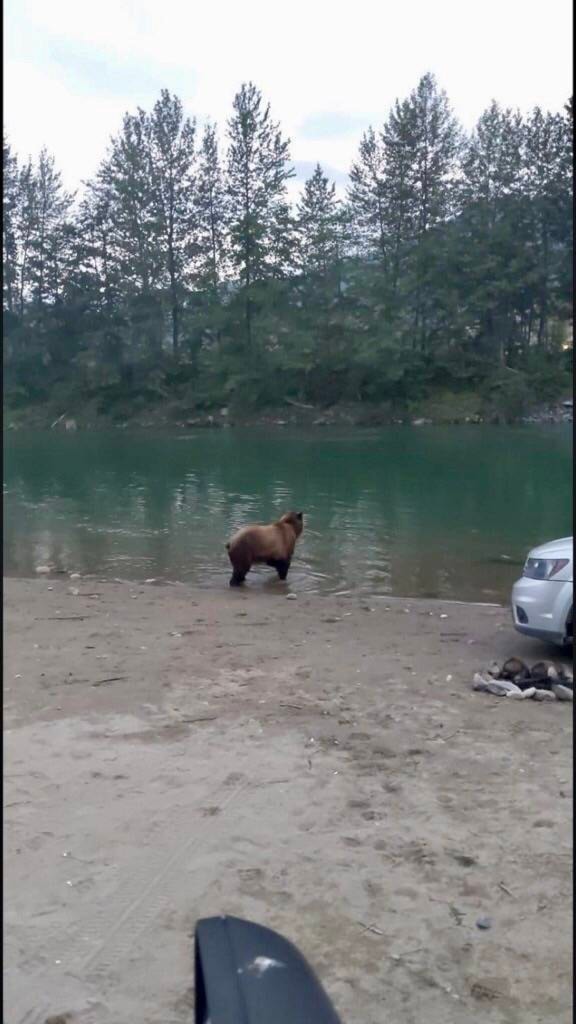Kitimat residents and anglers have been noticing that bears, especially grizzlies, have seemingly been more active and assertive than usual this year. Terrace Conservation Officer Service (COS) said that the bears aren’t necessarily more assertive, there’s just a higher number of them in the areas along the Kitimat River.
“There’s always bears that test the limits, you know, between humans and themselves,” Sgt. Tracy Walbauer of the Terrace COS said. “I don’t think bears are acting any more aggressive or less aggressive than they have in previous years, but you know, they’re hungry. They’re sourcing out food sources.”
READ MORE: Authorities urge residents to manage garbage and fish entrails after dispatching another bear
Walbauer said one of the key issues is the berry crop not being very good this year due to the cold weather in late May and into June. Berries are a main part of the bears’ food intake, but they’re unable to eat them for as long as usual due to the limited quantity.
“Bears are being pushed down to the river, where they might normally be up in the berry country for a little longer before they get down to the river.”
Along with that, there is a higher number of anglers on the Kitimat River this year due to the Skeena and Nass Rivers being mainly closed for fishing.
“We’re seeing high numbers of anglers like we did when Alcan expanded,” Walbauer said. “There’s lots of restrictions on the Skeena and the Nass, which could be — likely is — pushing people down to the Kitimat River because at least that river’s open.”
The Skeena and Nass Rivers have restricted fishing access mainly due to a lack of number of fish present in the waters, something Walbauer said Fisheries and Oceans has been looking into for a while.
“The Kitimat River is doing quite well, but when you look at the Skeena and the Nass, they’re struggling, for sure.”
Walbauer said there’s a healthy grizzly bear population that lives along the Kitimat River, and when that’s combined with the increase in anglers, the possibility of conflict increases, as well. Because of that, Walbauer said that, compared to other years, there has also been a higher number of bears they’ve had to destroy.
“You’re bound to have more resource users when you have more people, that’s just the way it works,” Walbauer said. “If you averaged it out over, say, the last 10 years, we’re in one of the years where, you know, interactions are very high and we are having a number of conflicts that have resulted in the destruction of bears.”
Walbauer said the number of bears destroyed this year is much higher than last year, and a generally high year if you averaged the last 10 years. He added that three years ago had a higher-than-average number of bears destroyed too, which he said was a direct result of a very small berry crop.
“Bears were very hungry and they were taking any opportunity they could to find food sources, and that included, you know, refuse and livestock and whatever else,” Walbauer said. “It looks like we’re on track to be another big year, for sure.”
READ MORE: VIDEO: Hide your picnic baskets, the bears are out
Walbauer said the main focus for Terrace COS going forward is remaining vigilant about educating people on their responsibilities when it comes to bear safety. This includes managing attractants, such as barbecues, fruit trees, bird feeders, and garbages; keeping things clean in yards and campgrounds; maintaining appropriate husbandry practices to minimize contact between bears and livestock; and cleaning up any fish and entrails from the riverbanks when fishing.
“Once bears…get into conflict, it’s very hard to break that pattern. If they’ve [been eating] garbage for a day or two, you know, it’s such a high calorie food source that…the addiction is there and it’s relatively hard to break.”
Walbauer said this is a tough situation to deal with, and they hope that Kitimat community members and visitors to the Kitimat River will respect the rules and stay responsible to keep both humans and bears safe.
clare.rayment@northernsentinel.com
Like us on Facebook and follow us on Twitter
